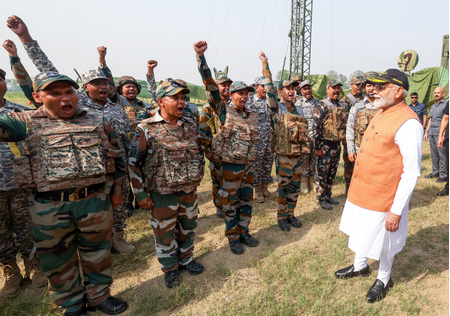
New Delhi, July 25 (IANS) As Prime Minister Narendra Modi surpasses Indira Gandhi, becoming India’s second-longest-serving Prime Minister after Jawaharlal Nehru, his 11-year tenure stands marked by a transformative overhaul of India’s defence sector, with a sharp focus on indigenous capabilities, swift military responses, and modernisation.
Since taking office in 2014, PM Modi has prioritised ‘Aatmanirbhar Bharat (self-reliant India)’ in defence manufacturing, reversing decades of import-dependency.
Under his leadership, India has emerged as one of the world’s top 25 arms exporters, with over Rs one lakh crore in defence exports reported in the last few years.
According to the Ministry of Defence, “Defence exports have grown 21 times, from Rs 4,312 crore in the 2004-14 decade to Rs 88,319 crore in the 2014-24 decade, highlighting India’s expanding role in the global defence sector.”
Key milestones include the successful production of LCA Tejas fighter jets, the development of the Prachand Light Combat Helicopter, and indigenous artillery systems like Dhanush and ATAGS, along with others.
“Strategic reforms, private sector involvement, and robust R&D have led to the development of advanced military platforms like the Dhanush Artillery Gun System, Advanced Towed Artillery Gun System (ATAGS), Main Battle Tank (MBT) Arjun, Light Specialist Vehicles, High Mobility Vehicles, Light Combat Aircraft (LCA) Tejas, Advanced Light Helicopter (ALH), Light Utility Helicopter (LUH), Akash Missile System, Weapon Locating Radar, 3D Tactical Control Radar, and Software Defined Radio (SDR), as well as naval assets like destroyers, indigenous aircraft carriers, submarines, frigates, corvettes, fast patrol vessels, fast attack craft, and offshore patrol vessels,” the MoD said.
The Modi government also greenlit the creation of two defence corridors — in Uttar Pradesh and Tamil Nadu — to attract private investment and promote local manufacturing. Over 70 per cent of India’s defence procurement budget in 2024-25 was earmarked for indigenous sources.
Strategically, PM Modi’s era has been defined by a decisive shift in India’s military posture. After the deadly terrorist attack at the Pathankot airbase in 2016 and the Uri Army camp attack later that year, India conducted its first cross-border surgical strikes, sending a clear message of zero tolerance toward terrorism.
This assertiveness was further amplified in 2019 with the Balakot airstrikes following the Pulwama attack, marking the first Indian air raid on Pakistani territory since 1971. In May 2025, the Indian Armed Forces launched Operation Sindoor, a massive retaliatory mission targeting terror launchpads across the LoC and PoK in retaliation for a deadly terror attack in Pahalgam on April 22, in which 26 innocents were gunned down by Pakistani-based terrorists.
The operation highlighted the Indian Army’s enhanced surveillance, strike precision, and integrated warfare capabilities. Modernisation has accelerated through key acquisitions like the Rafale fighter jets, Apache and Chinook helicopters, and S-400 missile systems.
The ageing MiG-29 fleet is being gradually phased out to make way for new-generation platforms like the AMCA (Advanced Medium Combat Aircraft), which is under development by HAL and DRDO.
As PM Modi crosses a historic milestone, India’s defence ecosystem stands significantly stronger — not just in hardware, but in strategic clarity, indigenous innovation, and global stature.
–IANS
sas/dpb



